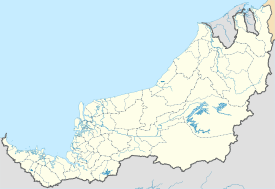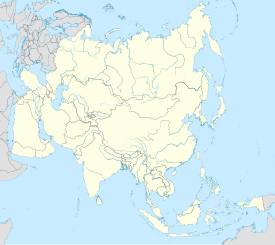
Back سيبو (ماليزيا) Arabic سيبو (بلده فى سيبو) ARZ Сибу Bulgarian Sĭ-bŭ CDO Sibu (lungsod) CEB Sibu Danish Sibu German Sibu DTP Sibu Esperanto Sibu Spanish
This article is written like a travel guide. (August 2021) |
This article contains too many pictures for its overall length. |
Sibu | |
|---|---|
Town and district capital | |
| Sibu Town Bandar Sibu | |
| Other transcription(s) | |
| • Jawi | سيبو |
| • Chinese | 诗巫 (Simplified) 詩巫 (Traditional) Shīwū (Hanyu Pinyin) Si-bû (Hokkien POJ) Sĭ-bŭ (Foochow Romanised) |
 Clockwise from top right: Wong Nai Siong Memorial Garden, Jade Dragon Temple, An-Nur Mosque, Masland Methodist church, Tua Pek Kong Temple, Wisma Sanyan, and swan statue. | |
| Nickname: "Swan City" | |
 Location of Sibu in Sarawak | |
| Coordinates: 02°17′16″N 111°49′51″E / 2.28778°N 111.83083°E | |
| Country | Malaysia |
| State | Sarawak |
| Division | Sibu |
| District | Sibu |
| Founded by James Brooke | 1862 |
| Settled by Wong Nai Siong | 21 January 1901 |
| Municipality | 1 November 1981 |
| Government | |
| • Type | Sibu Municipal Council |
| • Chairman | Clarence Ting Ing Horh |
| • Resident | Abang Mohamad Porkan Abang Budiman |
| Area | |
• Sibu city | 129.5 km2 (50.0 sq mi) |
| Elevation | 0 m (0 ft) |
| Highest elevation | 59 m (194 ft) |
| Population | |
• Sibu city | 162,676 |
| • Density | 1,256/km2 (3,250/sq mi) |
| • Metro | 240,165 |
| Time zone | UTC+8 (MST[8]) |
| • Summer (DST) | UTC+8 (Not observed) |
| Postal code | 96xxx[9] |
| Area code(s) | 084 (landline only)[10] |
| Vehicle registration | QS (for all vehicles except taxis) HQ (for taxis only)[11] |
| Website | www |
Sibu /ˈsiːbuː/ is a landlocked city located in the central region of Sarawak, Malaysia. It serves as the capital of Sibu District within Sibu Division and is situated on the island of Borneo. Covering an area of 129.5 square kilometres (50.0 sq mi),[12] the city is positioned at the confluence of the Rajang and Igan Rivers,[13] approximately 60 kilometres from the South China Sea[14] and 191.5 kilometres (119 mi) north-east of the state capital, Kuching.[15]
Sibu is characterised by its diverse population, with a significant portion being of Chinese descent, primarily from the Fuzhou region. While other ethnic groups such as Iban, Malay, and Melanau are also present, they are not as prominent in Sibu as in other parts of Sarawak.[16] As of 2010, the city had a population of 162,676 residents.[7]
The city's history dates back to its founding in 1862 by James Brooke, who built a fort to protect against attacks by indigenous Dayak people. Subsequently, a small group of Chinese Hokkien settlers established themselves around the fort, engaging in various business activities. In 1901, Wong Nai Siong led a significant migration of 1,118 Fuzhou Chinese from Fujian, China, to Sibu. Over time, infrastructure development took place, including the construction of the first hospital, Sibu bazaars, Methodist schools, and churches.
Sibu faced significant challenges in its history, enduring fires in 1889 and 1928 that destroyed the town. However, it was successfully rebuilt on both occasions. During the Second World War, Sibu fell under Japanese occupation, resulting in a renaming of the city to "Sibu-shu" in August 1942. After the Japanese surrender in 1945, Sarawak became a British Crown Colony. This led to unrest among young Melanau individuals in Sibu who were in favour of independence, culminating in the assassination of Sir Duncan George Stewart, the second British governor of Sarawak, during his visit to Sibu in December 1949. The perpetrator, Rosli Dhoby, was subsequently executed in 1950.
In the post-war period, Sibu and the Rajang basin became a center of communist activities, which continued even after Sarawak gained independence in 1963. The establishment of the Rajang Security Command (RASCOM) aimed to curb communist activities in the area, and the communist insurgency in Sarawak was eventually suppressed in 1973, coming to a complete end in 1990.
Sibu achieved municipality status in 1981 and received a royal visit in September 2001. Additionally, it has served as a gateway to the Sarawak Corridor of Renewable Energy (SCORE) since 2008. The city celebrated the 110th anniversary of the Fuzhou settlement in 2011.
Sibu serves as a prominent hub for tourism in the Upper Rajang River region, renowned for its scenic riverine towns and traditional longhouses inhabited by the Iban and Orang Ulu ethnic groups. Noteworthy landmarks within the city include Wisma Sanyan, recognized as the tallest edifice in Sarawak,[17] and Lanang Bridge, acclaimed as one of the lengthiest river bridges in the state.[18] Sibu also features the largest town square in Malaysia, adjacent to Wisma Sanyan.[17] Of historical significance is the Lau King Howe Hospital Memorial Museum, distinguished as Malaysia's inaugural and sole medical-themed museum. Equally prominent is the Sibu Central Market, a sprawling indoor marketplace recognised as the largest of its kind in Sarawak. Tourist attractions in Sibu encompass the Sibu Heritage Centre, Tua Pek Kong Temple, Bawang Assan longhouses, Sibu Old Mosque, Jade Dragon Temple, Bukit Aup Jubilee Park, and Bukit Lima Forest Park. The city also hosts vibrant cultural events such as the Borneo Cultural Festival (BCF) and the Sibu International Dance Festival (SIDF). Economically, Sibu thrives on the timber and shipbuilding industries, which have historically been central to its economic landscape.
- ^ "Clarence Ting's appointment as SMC chairman hailed by many". The Borneo Post. 23 August 2019. Retrieved 25 September 2019.
- ^ "History Of Sibu Municipal Council (SMC)". Sibu Municipal Council. Archived from the original on 12 August 2014. Retrieved 14 February 2015.
- ^ "Malaysia Elevation Map (Elevation of Sibu)". Flood Map : Water Level Elevation Map. Archived from the original on 22 August 2015. Retrieved 22 August 2015.
- ^ "Sibu, Malaysia Weather History and Climate Data". WorldClimate. Archived from the original on 29 December 2004. Retrieved 14 February 2015.
- ^ Cite error: The named reference
Bukitaupwas invoked but never defined (see the help page). - ^ "State statistics: Malays edge past Chinese in Sarawak". The Borneo Post. Archived from the original on 15 April 2016. Retrieved 15 April 2016.
- ^ "Current local time in Sibu, Malaysia". worldtimezone.com. Archived from the original on 8 July 2015. Retrieved 8 July 2015.
- ^ "Datasets Malaysia - Sibu". geopostcodes.com. Archived from the original on 10 September 2014. Retrieved 8 July 2015.
- ^ "Page 58 Sarawak Visitors Guide 2014 - Sibu & Central Sarawak". sarawak.gov.my. Sarawak State Government. Archived from the original on 8 July 2015. Retrieved 8 July 2015.
- ^ Soon, Teh Wei (23 March 2015). "Some Little Known Facts On Malaysian Vehicle Registration Plates". Malaysian Digest. Archived from the original on 8 July 2015. Retrieved 8 July 2015.
- ^ Shelley, Sii (10 April 2006). "About Sibu - Today's Sibu Town". Collaborative Resource Development - Universiti Malaya. Archived from the original on 5 February 2015. Retrieved 5 February 2015.
- ^ "Sibu". Encyclopædia Britannica. Retrieved 5 February 2015.
- ^ "Introducing Sibu". Lonely Planet. Retrieved 5 February 2015.
- ^ "Cheap flights from Sibu to Kuching". Trip Advisor. Retrieved 5 February 2015.
- ^ "Total population by ethnic group, sub-district and state, Malaysia, 2010 (page 376)" (PDF). Department of Statistics, Malaysia. Archived (PDF) from the original on 5 February 2015. Retrieved 5 January 2015.
- ^ a b Chris Rowthorn; Muhammad Cohen; China Williams (1 June 2008). Borneo. Lonely Planet. pp. 185–. ISBN 978-1-74059-105-8. Retrieved 18 February 2011.
- ^ "Wong upholds transformation of Sungai Bidut via dialogue". The Borneo Post. 26 January 2015. Retrieved 7 February 2015.




